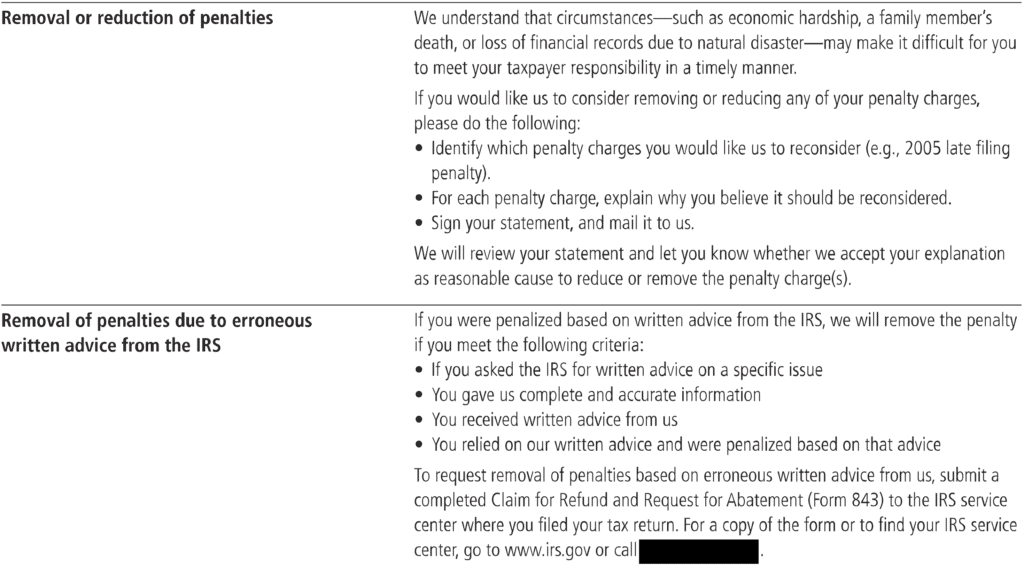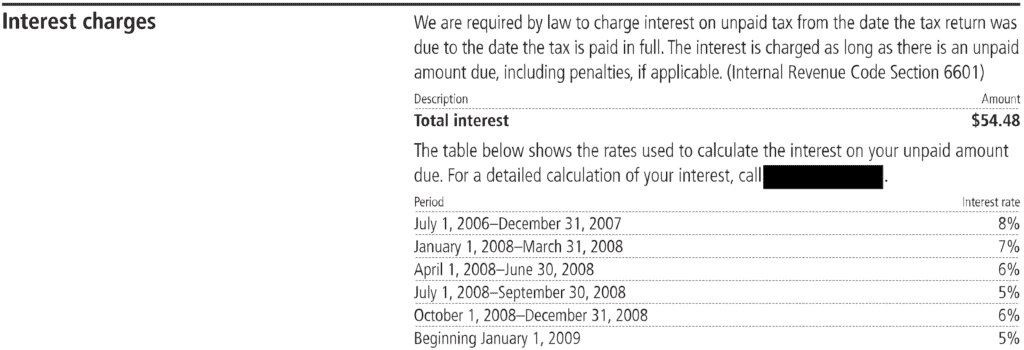IRS Notice CP501: What It Is and How to Respond
IRS Notice CP501 is the 1st Notice of a Balance Due. Now, this is a little bit confusing since the CP501 is actually not the first notice that the IRS typically sends you about your balance due; that distinction belongs to the CP14 Notice, and the CP501 Notice typically comes about five weeks after the CP14 Notice if you don’t respond to the CP14 Notice.
(And if you don’t respond to the CP501 Notice within five weeks, the IRS will typically send you the CP503 Notice.)
Here is a sample CP501 Notice.
Table of Contents
IRS Notice CP501 At a Glance
| Notice Type: | Collections |
| Generated By: | IRS ACS |
| Preceded By: | Notice CP14 |
| Followed By: | Notice CP503 |
| Recommended Action: | Enter Into Resolution |
IRS Notice CP501 Explained, Part by Part
Here is a full explanation of the Notice CP501, part by part.
Part 1: Billing Summary
On the first page of the CP501 Notice, the IRS gives a line-by-line summary of what they believe you owe.
This summary could include:
- The total amount of tax the IRS believes you owe, indicated as the “Amount you owed” line item
- The amount of any tax payments and credits on your account for the year — this is not included in the example image above because the taxpayer did not have any payments or credits on their account during the year
- The amount of any penalties the IRS has assessed on your account
- The amount of any interest the IRS has charged to your account
Part 2: What the IRS Wants You to Do
Obviously, the IRS is sending you this notice because they want you to take some kind of action — namely, pay the amount they believe you owe them within 10 days or at least make arrangements to pay them via an installment agreement.
Part 3: What the IRS Says They Will Do If You Don’t Respond
Next, the IRS lets you know that they will continue to charge penalties and interest on your account until you pay your balance.
They also let you know that they may even file a Notice of Federal Tax Lien on you and may take forced collection activity against you, such as garnishing your wages (up to a certain amount) and levying your bank account.
Part 4: Penalties
Next, the IRS lists out the penalties that it has assessed on you with a brief explanation of the penalties themselves.
In this example, the IRS has only charged the failure-to-pay penalty, but other common penalties you may see here are the failure-to-file penalty and the failure to pay estimated tax penalty.
Part 5: Information on Penalty Removal or Reduction
The IRS does allow for full or partial penalty abatement in certain circumstances — in the next section of the CP501 Notice, they provide some basic information about this process.
Part 6: Interest Charges Calculation
Finally, the IRS breaks down the interest they have charged you by quarter.
When the IRS Sends Notice CP501
The most common reason for the IRS sending you a CP501 Notice is when the following things happened:
- You filed a tax return for the year in question that indicated a balance due.
- You did not pay the amount due indicated on the return in full.
- The IRS previously sent you a CP14 Notice and you did not respond to it.
Another situation in which the IRS sends taxpayers a CP501 Notice is if the IRS itself prepared a substitute for return (SFR) for a taxpayer and the tax was assessed based on this SFR.
Or a taxpayer may have paid the balance due indicated on their return when they filed it — but they filed the return or at least paid the tax late, giving rise to penalties and interest that they have not yet paid.
Of course, the IRS is known to make mistakes, and it’s possible they are sending you the CP501 Notice in error because they didn’t properly credit your account for payments you made for the tax year.
What You Should Do If You Receive a CP501 Notice
Below are the steps you should take after you receive a CP501 Notice.
For more information about each of these steps, check out our article How to Fight the IRS and Win.
Step 1: Check the CP501 Notice for accuracy.
Don’t assume that the IRS did their math correctly — review the IRS’s numbers against your own.
Step 2: Correct any errors with the IRS.
If you do find an error in the IRS’s math, take it up with them.
There should be phone numbers in the CP501 Notice itself that you can call to discuss your disagreement with the IRS’s numbers:
- For example, in the “What you need to do immediately” section, there will likely be a phone number that you can call to “discuss your options.” If you disagree with the tax amount itself, call this number.
- In the “Penalties” section, there should be a number indicated that you can call to obtain a “detailed calculation of your penalty charges.” If you disagree with the IRS’s penalty calculation, call this number.
You can always reach out to us at at 866-8000-TAX to go to bat against the IRS for you.
Step 3: Seek Penalty Abatement.
For most of our clients with penalties on their account, we at least seek some sort of penalty relief for them.
Sometimes the IRS grants it; sometimes they don’t.
But it’s generally at least worth a shot.
For more information about seeking abatement for the penalties on your account, check out this article.
Step 4: Pay the Balance Due OR Seek Tax Relief
Finally, you have to figure out what to do with the amount you owe the IRS after you’ve cleared up any disagreements with them concerning the amount as well as obtained any possible penalty relief for your account.
You can, of course, pay off your balance in full. This will (obviously) stop future penalties and interest from accruing.
However, a better option — if you qualify for it — is an offer in compromise. An offer in compromise is an agreement you make with the IRS in which the IRS agrees to accept a lower amount to satisfy your tax debt than you actually owe.
That said, not all taxpayers qualify for an offer in compromise, so there are other options, such as a temporary hardship placement called currently not collectible status as well as installment agreements for taxpayers who wish to pay their balance over time.
For an overview of how tax relief works, read our article What Is Tax Relief and How Does It Work?.
What If I Already Paid the Amount on My CP501 Notice?
If you’ve already paid the amount indicated on your CP501 Notice, you can disregard the notice.
In fact, the IRS says in the “What you need to do immediately” section:
“If you’ve already paid your balance in full within the past 14 days or made payment arrangements, please disregard this notice.”
In this case, it’s possible that the IRS had already generated the CP501 Notice before it had processed your payment. This is not a big deal — it will simply take the IRS a few days (or even a couple weeks) to catch up.














